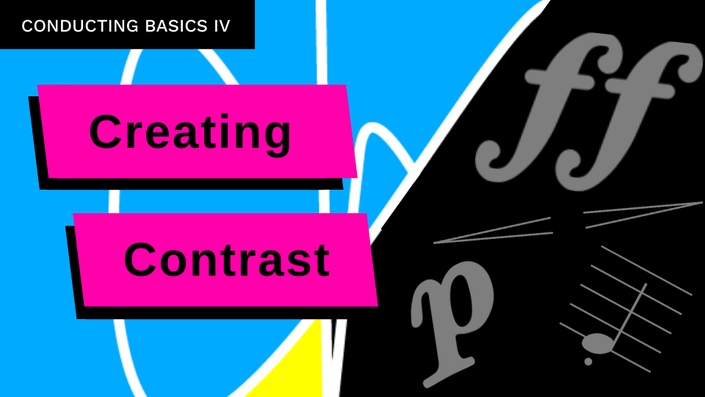
Conducting Basics IV - Creating Contrast
Learn the tools of light, shade & expression
Review and refine your fundamentals.
Conducting Basics - Creating Contrast will equip you to:
- Conduct a wide variety of articulations, including staccato, legato, accents & marcato
- Convey the full spectrum of dynamics using gestures that actually change the ensemble's sound
- Create more expression with your left hand
- Give cues that communicate not just when to play, but how to play
- Negotiate complex tempo changes
Check out the course content below to see the full details.
Become a better conductor.
How do you actually conduct a crescendo well?
Wish you could go back in time and watch those lessons as often as you want? With lifetime access to the course, you can watch the instructional videos as many times as you want, whenever you want. You can even rewind to just watch one single gesture.
Or perhaps you've never had any conducting training, but you've been thrust in front of an ensemble as part of your job. Where do you even begin?
Begin here!
Solve real-world problems immediately.
- Band got sloppy articulation?
- Orchestra not using enough bow?
- Choir singing only at one dynamic?
Using the Musical Issues Index you can easily find the relevant lesson. You can go to any lesson at any time, so you can get what you need, when you need it.
Solve your nagging issues.
Do you have musical issues that constantly crop up in your rehearsals, time and time again? Perhaps you wish your ensemble would play with more dynamic contrast. Or you've noticed the ensemble always play fuzzy staccato. Maybe your ensemble is wonky on tempo changes. Or you're wondering how you can help the ensemble to just watch more.
Find the conducting solutions to common musical problems.
Many of these common musical issues can be solved with tweaks to your conducting gestures. The result? Better ensembles, new positive habits, and more efficient rehearsals.
Be more expressive.
We often begin as conductors like musicians - focussing on the nuts and bolts of technique, without having anything musical to say. For a while, this works as we focus on how to wave our stick. But with more experience on the podium, we come up with ideas and emotions we want to express, but we no longer remember the tools and techniques needed to share them.
In the course, you'll discover the basic processes and principles behind each gesture and how it will influence the ensemble's sound. So once you know what sound you want, you'll be equipped with exactly how to show it in your conducting.
More time making music, less time talking.
Great conducting is great rehearsing.
Conducting Basics helps you not only learn basic techniques, but know how to critique your own conducting and practice your new skills.
Your Instructor

In demand internationally as a clinician, guest conductor and lecturer, Ingrid is renowned for her ability to lead ensembles to deeper, meaningful musical performances. She has spent the last 15 years leading transformative musical experiences for musicians in schools, universities and community ensembles.
Committed to conductor education, she has served as State President of the Australian Band & Orchestra Directors' Association (ABODA), taught conducting to graduate students at the University of Melbourne, and continues provides individual tuition to hundreds of teachers through private tuition, festivals and competitions across Australia.
